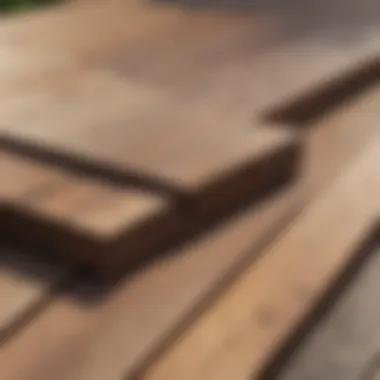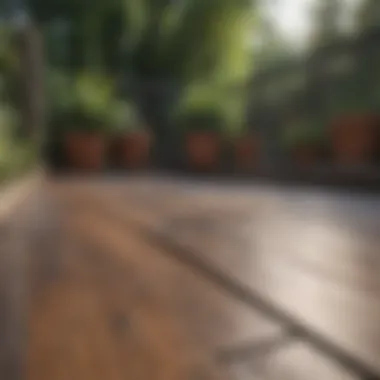Understanding Deck Board Installation Costs


Intro
Decks serve many purpose; they extend living space and enhance outdoor enjoyment. However, the costs associated with installing deck boards can be complex and varied. Homeowners and professionals must grasp how different factors influence pricing. This article will examine important elements such as materials, labor, project size, and differences based on region. Understanding these aspects allows for informed decisions which can impact financial outcomes in the long run.
Installing deck boards might seem straightforward, but beneath the surface, there is much to consider. Financial implications differ greatly depending on the choices made, from the type of material to maintenance requirements. This comprehensive guide intends to demystify the costs linked to deck board installation, serving as a resource for those about to embark on their deck projects.
Materials Considerations
When choosing deck boards, material selection is essential. Each type offers unique benefits and costs.
Common Deck Board Materials
- Pressure-Treated Wood: This is one of the most affordable choices. It withstands weather well but requires regular maintenance to prevent rot and warping.
- Composite Decking: Made from a blend of wood fibers and plastics, composite materials might have a higher initial cost but promise durability and low maintenance.
- PVC Decking: Completely synthetic, PVC decking is resistant to moisture and fading. It can be pricier but lasts much longer without upkeep.
- Hardwood: Exotic woods like ipe offer stunning aesthetics but come at a significant premium.
Different materials influence the total quoting price. Composite and PVC materials often require less manual labor when installing, potentially balancing out their higher up-front costs.
Labor Costs
Labor can contribute significantly to the total cost of deck installation. Rates fluctuate based on various elements:
- Experience of the Installer: Skilled professionals may charge more but can provide better craftsmanship.
- Time Frame: Urgent projects may require overtime work, increasing labor costs.
- Local Market Rates: Prices for labor can vary greatly by geographic location. In urban areas, wages tend to be higher compared to rural settings.
Choosing an Installer
Finding a trusted contractor can impact both cost and quality. Recommendations from friends or family can help narrow options. Review previous work and obtain multiple quotes to ensure fair pricing.
Project Size
The scale of your decking project directly impacts costs. Here are some considerations:
- Dimensions: A larger deck obviously increases material and labor costs.
- Complexity of Design: Intricate layouts demand more labor and skills, escalating expenses.
- Accessibility: If the site for installation is hard to reach, that could entail additional charges for labor.
Regional Price Variations
Pricing for deck board installation differs by region due to labor costs, material availability, and demand levels:
"Factors such as demand and local regulations can dictate price fluctuations in different areas."
In regions with high demand for outdoor living spaces, such as California or Florida, costs may reflect this popularity. Conversely, areas with lower demand may present more competitive pricing.
Maintenance and Durability
Lastly, consider the long-term financial implications of your choices. The cost of maintenance should be factored into your decision:
- Pressure-Treated Wood requires treatment and upkeep to remain in good condition, which can add up over time.
- Composite and PVC options, while more expensive initially, often outlast wood and require less maintenance.
- Hardwoods need regular sealing and cleaning to maintain their appearance and durability.
Understanding these considerations aids in creating a more comprehensive view of potential expenses. By evaluating all relevant aspects, homeowners can invest wisely in their outdoor spaces, resulting in lasting satisfaction.
Preface
Installing deck boards is not merely about creating an outdoor space. It’s about aligning various factors to achieve a balance between aesthetics, functionality, and budget. Understanding the costs associated with deck board installation serves as a crucial first step for homeowners and design enthusiasts alike. This article delves into intricacies of the costs involved, breaking down elements such as material selection, labor expenses, and design complexity.
One of the main reasons to comprehend these costs is the potential impact on your overall project. By getting a clear view of what influences pricing, you can strategize effectively. It allows for informed choices that match your financial parameters and requirements. For example, a decision to opt for composite decking versus traditional wood significantly alters the financial landscape of your project.
Additionally, factors such as seasonal trends and market influences play a role in fluctuating costs. Awareness of these can prevent surprise expenses and poor planning. Proper budgeting directly correlates with project success, and understanding how different segments contribute to total cost helps ensure an enjoyable outdoor environment in alignment with your vision.
Choosing deck materials, understanding regional labor costs, or estimating project complexity can feel daunting. However, this article aims to simplify these factors, presenting them in an accessible manner. This way, homeowners will be better equipped to navigate the maze of options and prices effectively. Not only does this approach guide the design choices but also fosters a better appreciation of the long-term implications of such investments.
In summary, gaining insight into the costs associated with installing deck boards is essential. It brings clarity to decision-making processes and prepares homeowners for what lies ahead in their deck-building journey.
Factors Influencing Deck Board Installation Costs


The costs associated with installing deck boards can vary significantly based on several influential factors. Recognizing these elements is crucial for homeowners and professionals alike. A deeper understanding of what drives these costs helps in making informed financial decisions for deck installations. The combination of material selection, labor costs, project size, and market fluctuations can heavily impact the overall expense of your deck project.
Material Selection
Types of Decking Materials
When considering types of decking materials, the options are diverse. Each type, such as composite, wood, or vinyl, brings distinct characteristics. Composite decking, for instance, is created from a mix of wood fibers and recycled plastic. This unique combination offers enhanced durability while minimizing maintenance needs. On the other hand, traditional wood decking presents a warm, natural aesthetic, yet requires more upkeep over time to avoid rot or warping. Understanding these unique features can guide the decision on which material aligns best with both preference and budget.
Cost Variations Among Materials
Cost variations among materials are vital to consider. Each type of decking material comes with its own price point. For example, while composite decking may offer higher upfront costs, its longevity and reduced maintenance may yield savings in the long term. Wood, depending on the species, can range from relatively affordable pressure-treated lumber to more expensive hardwoods like cedar or redwood. It’s important to weigh these costs against the expected lifespan and maintenance needs of the materials chosen.
Labor Costs
Understanding Labor Fees
Understanding labor fees is essential for estimating deck installation costs. Labor rates can vary widely by region and complexity of the job. A thorough breakdown of labor costs will reveal not only hourly rates but also additional charges for specific skills or tools required for the installation. Knowledge in this area helps in budgeting appropriately and selecting the right contractor capable of delivering quality work.
Regional Labor Cost Differences
Regional labor cost differences also significantly affect total installation expenses. Labor may be cheaper in certain areas due to less demand or lower living costs. Conversely, urban areas may encounter higher labor fees driven by demand and the cost of living. Understanding these regional variances can help in planning and potentially lead to substantial savings.
Project Size and Complexity
Estimating Deck Size
Estimating deck size is an important step that directly impacts overall costs. A larger deck means more material and labor, subsequently increasing installation costs. A precise calculation ensures accurate budgeting and prevents surprises during the process. Factors such as shapes, levels, and features like railings add complexity and should be factored into size estimates.
Impact of Design Complexity
The impact of design complexity cannot be overlooked. Architectural features such as multi-level decks, intricate railing designs, and built-in seating can drive up both material costs and labor fees. Homeowners should aim to strike a balance between desired aesthetics and budgetary constraints. Understanding this dynamic can aid in decisions that align both style and financial considerations effectively.
Seasonal and Market Influences
Seasonal Demand Fluctuations
Seasonal demand fluctuations can dramatically affect installation costs. During peak seasons, such as spring and summer, materials and labor may become pricier due to increased demand. Conversely, winter months may offer lower prices as demand decreases. Recognizing these trends can provide homeowners with opportunities for cost savings by timing their projects strategically.
Market Pricing Trends
Market pricing trends also play a critical role in influencing installation costs. Prices of materials can rise or fall based on supply chain issues, economic factors, and even environmental events. Staying informed about current market trends may help in making smart purchasing decisions. An awareness of these factors reinforces the need for research and understanding in financial planning for deck projects.
Types of Decking Materials and Associated Costs
When considering deck installation, the choice of materials plays a crucial role. Different materials bring varying costs, aesthetics, and maintenance needs. Understanding these aspects helps decision-makers align their choices with both their budget and desired outcomes. Moreover, each material type carries its own set of pros and cons, impacting not just the initial expenses but also the long-term financial implications.
The primary materials generally discussed are composite decking, wood decking, and vinyl decking. Each of them caters to different homeowner preferences and requirements, making the knowledge of their costs and qualities essential.
Composite Decking
Cost Overview
Composite decking has gained recognition over the yers for its blend of wood fibers and plastic. This composition typically results in moderate to high pricing when compared to traditional wood options but often justifies the cost through added durability. Generally, prices range between $2 to $5 per linear foot.
It is resistant to fading, stains, and mold growth, which translates to lower maintenance costs in the long run. The investment in composite can often be rationalized by these lower future expenditures.
Pros and Cons
The primary advantage of composite decking lies in its minimal upkeep. This material does not require painting or staining, and it resists the degradation that often plagues traditional wooden materials. However, the initial costs can be off-putting for some consumers. Additionally, while composite decking is strong, it may not have the same aesthetic appeal as natural wood for those who prioritize traditional looks.
Wood Decking
Different Wood Types


Wood decking is a classic choice for a reason. Its vibrant natural beauty is often unmatched. Various types, including pressure-treated pine, cedar, and redwood, have different price points, typically from $1 to $5 per linear foot based on type and quality. Pressure-treated pine is common for budget-conscious shoppers, whereas cedar and redwood offer greater durability and aesthetics, typically attracting higher costs.
Cost Analysis and Longevity
In comparing cost and longevity, hardwood options often provide a better value over time. While they might be more expensive upfront, they tend to withstand elements longer, reducing the frequency of replacement. Also, treating wood regularly can ensure optimal performance and longevity.
Vinyl Decking
Pricing Structure
Vinyl decking is often seen as a contemporary alternative. It typically falls between $3 to $6 per linear foot, depending on the manufacturer and design. One distinct benefit of vinyl is its resistance to splintering, cracking, or warping, making it ideal for high-traffic areas.
Durability and Maintenance
Regarding durability, vinyl outlasts many wood options. Its resilience to weather changes means that homeowners can expect less wear and tear, needing fewer repairs and replacements. However, while it is easy to maintain, some may find the aesthetics less appealing compared to rich wood grains.
"Choosing the right decking material is not just an investment in the present, but a long-term decision that affects usability and maintenance down the line."
Estimating Total Installation Costs
Estimating total installation costs is crucial when planning a deck project. It encompasses various elements that directly influence the overall budget, making it essential for homeowners to have a clear understanding. This section focuses on three main aspects: cost breakdown, which includes material costs, labor fees, and additional expenses; and calculating return on investment, which evaluates the value added to the property and considers long-term financial implications. Accurate estimations prevent unexpected expenses and ensure proper financial planning.
Cost Breakdown
Material Costs
Material costs are a significant factor in estimating total installation costs for deck boards. These costs depend on the type and quality of materials chosen, which can vary widely. Materials like composite decking often represent a popular choice due to their durability and low maintenance. However, the initial investment for these materials can be higher compared to traditional wood.
The unique feature of material costs is their direct impact on long-term upkeep. Choosing higher-quality materials can lead to fewer repairs and replacements down the line, saving money over time. On the other hand, opting for lower-cost materials might result in frequent maintenance that adds to overall expenses.
Labor Fees
Labor fees also play a crucial role in the total cost of deck installation. Skilled labor usually comes at a premium but ensures high-quality work. Hiring professionals can often lead to better long-term results, as mistakes during installation can be costly to fix. The unique characteristic here is that labor rates can vary significantly based on geographical location, complexity of the project, and the contractor's expertise.
Although hiring professionals may seem expensive initially, their knowledge and experience can prevent potential pitfalls. On the downside, DIY options might reduce immediate spending but can lead to higher costs if errors occur during the process.
Additional Expenses
Additional expenses must also be factored into the overall estimation. These can include costs like permits, inspections, and cleanup. They often vary depending on local regulations, meaning they are sometimes overlooked in the planning phase. Being aware of these potential costs is important because they can accumulate quickly, impacting the overall budget.
The unique nature of additional expenses lies in their unpredictability. While some costs can be easily anticipated, others may arise unexpectedly, leading to financial strain. Having a budget that accounts for these expenses can safeguard against surprises.
Calculating Return on Investment
Assessing Value Addition to Property
Assessing the value addition to property is essential for homeowners considering a new deck. A well-built deck enhances outdoor living space, which can significantly increase property value. The attractiveness and functionality of the new deck can appeal to future buyers, making it a beneficial investment.
The key characteristic here is the potential return on investment. According to various studies, well-planned outdoor enhancements can yield a solid return, often recouping a significant portion of the initial costs. This makes investing in high-quality materials and skilled labor worthwhile in the long run.
Long-term Financial Considerations
Long-term financial considerations are important for any homeowner thinking about deck installations. It's not just about initial costs; understanding future expenses related to repairs and maintenance is critical. Choosing materials with better durability can mean fewer costs in the future, thus providing savings over time.
A unique feature of long-term financial considerations is their interconnectedness with market trends. As landscaping and outdoor living space become more valued in real estate, the financial implications of an investment in decking can increase. Thus, evaluating these factors creates a more comprehensive understanding of whether the investment will pay off.
Properly estimating all costs involved in deck installations is key to effective financial planning. A well-informed homeowner makes for a smoother project.
Long-term Maintenance and Upkeep Costs
Considering long-term maintenance and upkeep costs is vital for homeowners looking to install deck boards. Understanding these expenses is crucial as they directly affect the overall investment in a deck. Neglecting to factor in maintenance may lead to significant costs down the road. Regular care and repairs ensure the deck remains safe, functional, and visually appealing. If you wish to preserve your investment, maintaining the deck properly matters.


Routine Maintenance Expenses
Regular Cleaning and Care
Regular cleaning and care are essential components of maintaining a deck. This process not only keeps the surface free of dirt and stains but also prevents damage from the accumulation of debris. For instance, mold and mildew can develop if moisture is trapped, especially in shaded areas. Regular cleaning helps in spotting these issues before they escalate.
The key characteristic of regular cleaning is its preventive nature. It is a beneficial choice as it fosters a healthy lifespan for your deck, potentially reducing long-term costs. Decks that receive adequate care often require fewer major repairs. The unique feature of regular cleaning lies in its simplicity; often, just soap, water, and a gentle scrub are all that are necessary. However, some homeowners might overlook this task, which can lead to more significant expenditures later on.
Repair Costs Over Time
Repair costs over time can accumulate significantly if not addressed timely. Minor damages, if ignored, can become more significant and thus more expensive to fix. For example, a cracked board can lead to rotting if water is allowed to seep in. This can affect not only the aesthetics but also the safety of the deck.
The key characteristic of repair costs is their unpredictable nature. It is important to anticipate these expenses. Minor repairs are easier and cheaper to manage than larger structural issues that arise from neglect. The unique feature of repair costs is that they can often be mitigated by proactive maintenance. However, uncertainty can be a disadvantage, as unforeseen issues may arise, leading to unplanned expenses.
Material Longevity and Performance
Comparative Durability
Comparative durability refers to how different materials hold up over time under various conditions. Selecting durable materials can lower maintenance and repair costs. For example, composite decking often outperforms wood in terms of longevity. This characteristic makes it a popular choice among homeowners looking for lower upkeep.
The unique aspect of comparative durability is that it showcases the strengths and weaknesses of each material. While more pricey upfront, materials like composite can save homeowners money long-term. On the contrary, cheaper materials might need replacement sooner, ultimately costing more. Thus, understanding material options thoroughly is crucial for making an informed choice.
Impact of Environment on Material Lifespan
The impact of environment on material lifespan is a critical factor to consider when purchasing decking materials. Local climate can have significant effects on how materials perform. For instance, decks in humid areas may be prone to mold and decay. Similarly, regions with harsh winters may see faster wear and tear on softer woods.
The key characteristic of this impact is its variability. Different environments require different maintenance strategies. Some materials may be better suited for certain climates, leading to longer lifespans. The unique feature of environmental impact is that it can influence both selection and long-term performance. Homeowners must carefully assess their local environment to choose the most suitable materials and maintenance plans.
Common Mistakes to Avoid
Installing deck boards can be an exciting project, but there are common mistakes that can significantly impact both the budget and quality of the installation. This section outlines these mistakes, emphasizing why avoiding them is crucial for a successful deck installation. Understanding these pitfalls helps homeowners manage costs more effectively and ensures a better overall result.
Underestimating Material Needs
Consequences of Insufficient Materials
When you miscalculate the amount of decking material required, it can lead to several complications. One significant consequence is project delays. If you run out of materials halfway through, you may need to reorder, which can prolong the installation process. This delay can escalate costs, especially if labor is involved. Another critical aspect is inconsistency in material quality or color, as different batches might not match. This ultimately impacts the aesthetic appeal of your deck, which is important for both you and potential buyers in the future. Thus, ensuring you have enough materials saved you time and effort.
Strategies to Prevent Waste
Preventing waste is essential for keeping the budget in check. One effective strategy is to plan your layout carefully before making a purchase. Using a precise estimate based on the dimensions of your deck can eliminate unnecessary waste. Also, consider purchasing a little extra to cover mistakes or miscalculations. Buying in bulk can often result in better pricing, avoiding inflated costs later on. Another practical approach is to utilize scraps from your cuts whenever possible, promoting sustainability while minimizing loss.
Neglecting Professional Advice
Importance of Expert Consultation
Seeking professional advice from contractors or decking specialists is a wise move. Experts can provide insights into proper installation techniques and recommend the right materials based on your specific climate. Their experience can identify hidden costs or challenges early in the planning process. Engaging with an expert not only streamlines the process but often results in a tighter budget, as they can advise you on avoiding common mistakes.
Potential Cost Implications of DIY Errors
DIY projects can be appealing due to the potential savings. However, neglecting professional guidance often leads to errors. These mistakes can force you to remediate issues or redo incomplete work, leading to unexpected costs. Further, errors in installation can decrease the longevity of your deck, resulting in higher maintenance needs down the line. Ultimately, avoiding professional advice may seem cost-effective at first but can reveal hidden cost implications that surpass initial savings.
End
In discussing the costs of installing deck boards, this article highlights several critical elements that can affect both short-term and long-term financial decisions for homeowners. By understanding various factors such as material choices, labor expenses, project complexity, and market conditions, readers gain a clearer perspective on what to anticipate when budgeting for their deck project.
One significant takeaway is the importance of selecting the right material for both durability and cost-efficiency. Each type of decking material, whether it be composite, wood, or vinyl, comes with its own profile of expenses and maintenance requirements. Homeowners should weigh the initial outlay against potential future maintenance costs and longevity of the material.
Furthermore, labor costs can fluctuate widely based on regional disparities and contractor availability. Gaining insight into these variables allows for better planning and may steer decision-making towards more economical options.
The choice of project size and complexity also merits attention; larger and more intricate designs can dramatically increase both material and labor costs. Thus, careful initial design planning can yield significant savings.
Lastly, the article outlines the crucial role of market influences and seasonal trends that emerge in the home improvement landscape. Being aware of these factors enables homeowners to strategically time their purchases or installations to maximize value.
By synthesizing these insights, this article equips readers with the tools necessary to make informed decisions regarding deck installations. The ability to balance quality, cost, and long-term investment can ultimately lead to a more satisfying outdoor living space that adds both aesthetic and financial value to the property.
"The right preparation and understanding of costs pave the way for a successful deck installation, ensuring that your outdoor space meets both your needs and expectations."
In closing, a thorough grasp of the installation costs fosters confidence and skillful project management, transforming a simple backyard into an inviting gathering place for family and friends.



